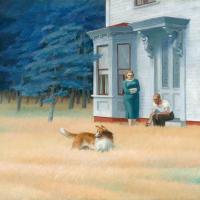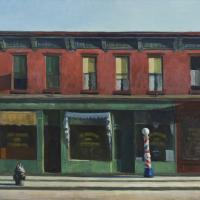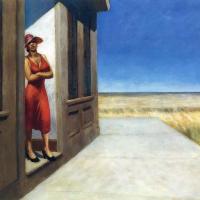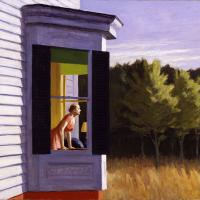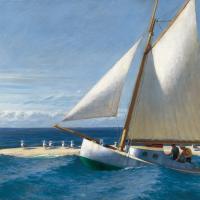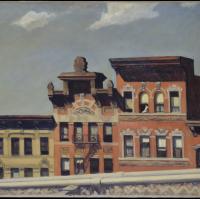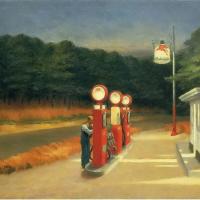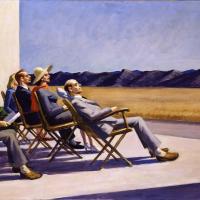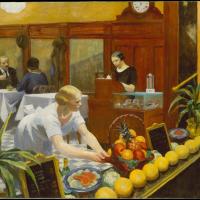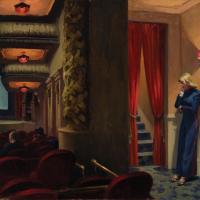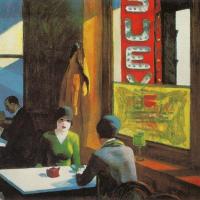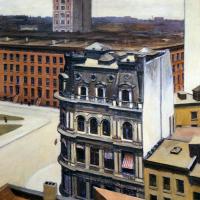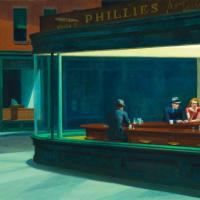Edward Hopper
Cape Cod Evening
$450.00
Early Sunday Morning
$450.00
Gas
$450.00
Officeatnight
$450.00
People In The Sun
$450.00
Tables For Ladies
$450.00
Two On The Aisle
$450.00
YORK'S MOVIES
$450.00
Chop Suey
$450.00
city
$80.00
Nighthawks
$450.00
Edward Hopper
Edward Hopper (1882-1967)
Edward Hopper (July 22, 1882 – May 15, 1967) was an American realist painter and printmaker. While he is best known for his oil paintings, he was equally proficient as a watercolorist and printmaker in etching. Both in his urban and rural scenes, his spare and finely calculated renderings reflected his personal vision of modern American life.
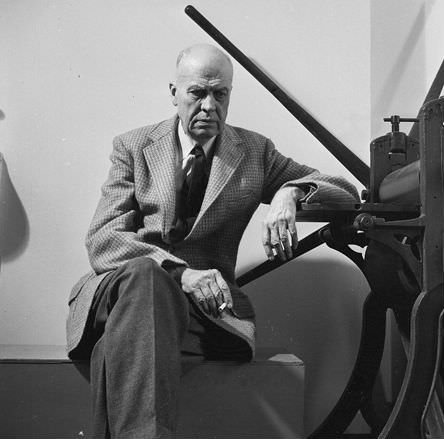
Hopper's influence on the art world and pop culture is undeniable. Though he had no formal students, many artists have cited him as an influence, including Willem de Kooning, Jim Dine, and Mark Rothko. An illustration of Hopper's influence is Rothko's early work Composition I (c. 1931), which is a direct paraphrase of Hopper's Chop Suey.
Hopper's cinematic compositions and dramatic use of light and dark has made him a favorite among filmmakers. For example, House by the Railroad is reported to have heavily influenced the iconic house in the Alfred Hitchcock film Psycho. The same painting has also been cited as being an influence on the home in the Terrence Malick film Days of Heaven. The 1981 film Pennies from Heaven includes a tableau vivant of Nighthawks, with the lead actors in the places of the diners. German director Wim Wenders also cites Hopper influence. His 1997 film The End of Violence also incorporates a tableau vivant of Nighthawks, recreated by actors. Noted surrealist horror film director Dario Argento went so far as to recreate the diner and the patrons in Nighthawks as part of a set for his 1976 film Deep Red (aka Profondo Rosso). Ridley Scott has cited the same painting as a visual inspiration for Blade Runner. To establish the lighting of scenes in the 2002 film Road to Perdition, director Sam Mendes drew from the paintings of Hopper as a source of inspiration, particularly New York Movie.
Homages to Nighthawks featuring cartoon characters or famous pop culture icons such as James Dean and Marilyn Monroe are often found in poster stores and gift shops. The cable television channel Turner Classic Movies sometimes runs animated clips based on Hopper paintings prior to airing its films. Hopper's painting New York Movie was featured in the television show Dead Like Me; the girl standing in the corner resembles Daisy Adair. In a 1998 episode of That '70s Show titled "Drive In," Red and Kitty settle in at a diner and create a reproduction of Nighthawks.
Musical influences include singer/songwriter Tom Waits's 1975 live-in-the-studio album titled Nighthawks at the Diner, after the painting. In 1993, Madonna was inspired sufficiently by Hopper's 1941 painting Girlie Show that she named her world tour after it and incorporated many of the theatrical elements and mood of the painting into the show. In 2004, British guitarist John Squire(formerly of The Stone Roses) released a concept album based on Hopper's work entitled Marshall's House. Each song on the album is inspired by, and shares its title with, a painting by Hopper. Canadian rock group The Weakerthans released their album Reunion Tour in 2007 featuring two songs inspired by and named after Hopper paintings, "Sun in an Empty Room", and "Night Windows", and have also referenced him in songs such as "Hospital Vespers". Hopper's Compartment C, Car 293 inspired Polish composer Paweł Szymański's Compartment 2, Car 7 for violin, viola, cello and vibraphone (2003), as well as Hubert-Félix Thiéfaine's song Compartiment C Voiture 293 Edward Hopper 1938 (2011). Hopper's work has influenced multiple recordings by British band Orchestral Manoeuvres in the Dark. Early Sunday Morning was the inspiration for the sleeve of Crush (1985). The same band's 2013 single "Night Café" was influenced by Nighthawks and mentions Hopper by name. Seven of his paintings are referenced in the lyrics.
Each of the twelve chapters in New Zealander Chris Bell's 2004 novel Liquidambar (UKA Press/PABD) interprets one of Hopper's paintings to create a surreal detective story.
Hopper's influence reached the Japanese animation world in the dark cyberpunk thriller Texhnolyze. His artwork was used as the basis for the surface world in Texhnolyze as well as for much of the 2008 animated film Bolt.
Works by Hopper rarely appear on the market. The artist was not prolific, painting just 366 canvases; during the 1950s, when he was in his 70s, he produced approximately five paintings a year. Hopper's longtime dealer, Frank Rehn, who gave the artist his first solo show in 1924, sold Hotel Window (1956) to collector Olga Knoepke for $7,000 (equivalent to $62,444 in 2018) in 1957. In 1999, the Forbes Collection sold it to actor Steve Martin privately for around $10 million. In 2006, Martin sold it for $26.89 million at Sotheby's New York, an auction record for the artist.
In 2013 the Pennsylvania Academy of Fine Arts put Hopper's East Wind Over Weehawken (1934) up for sale, hoping to garner the $22–$28 million at which the painting is valued, in order to establish a fund to acquire "contemporary art" that would appreciate in value. It is a street scene rendered in dark, earthy tones depicting the gabled house at 1001 Boulevard East at the corner of 49th Street in Weehawken, New Jersey, and is considered one of Hopper's best works. It was acquired directly from the dealer handling the artist's paintings in 1952, fifteen years before the death of the painter, at a very low price. The painting sold for a record-breaking $36 million at Christie's in New York, to an anonymous telephone bidder. That same year, Weehawken resident and comedian Susie Felber commissioned a modern remake of the painting in order to raise money for the Weehawken PTPO. The remake, which was created by Brooklyn-based painter Stephen Gardner, depicts the scene as it appears today, with flowers and satellite dishes, and in lighter tones. The painting was purchased on eBay for $510 by computer programmer Ligia Builes, who owns the house depicted in the painting.
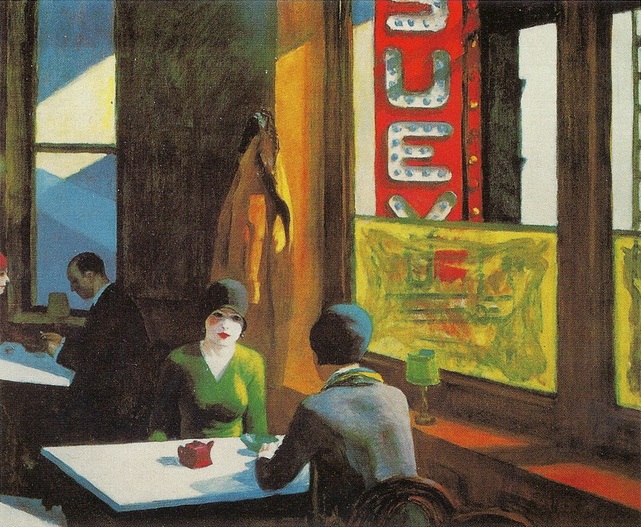
Chop Suey (1929)
In 2018, after the death of art collector Barney A. Ebsworth and subsequent auction of many of the pieces from his collection, Chop Suey (1929) was sold for €92 million, becoming the most expensive of Hopper's work ever bought at auction.
source: wiki


